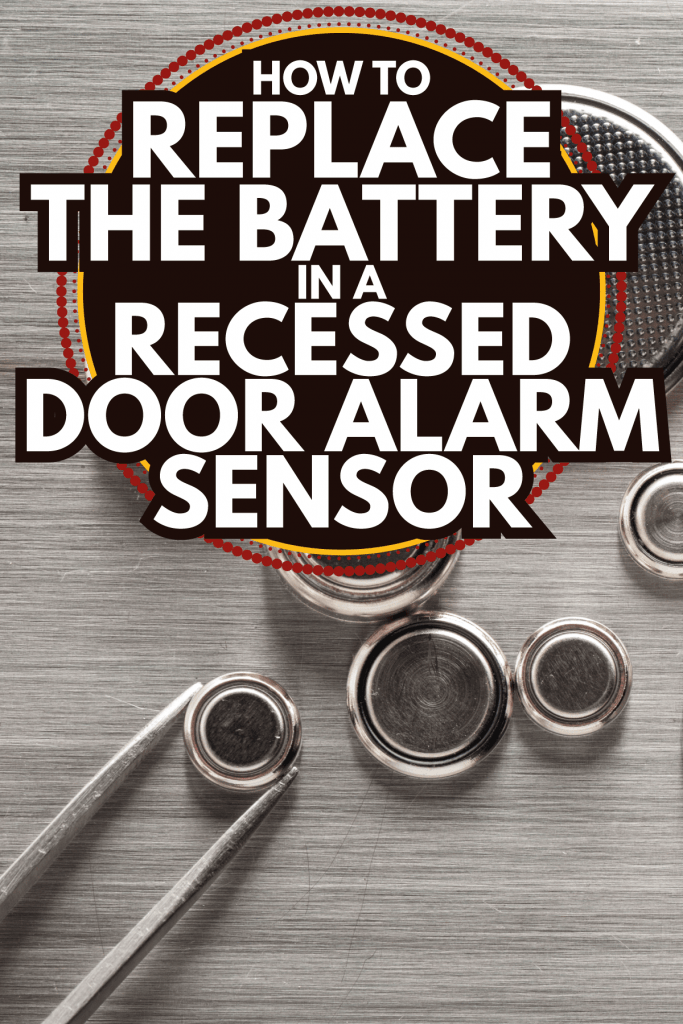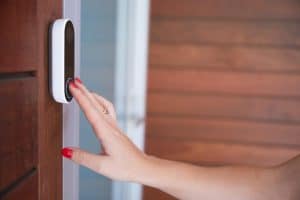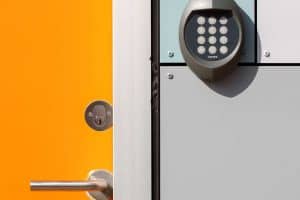Recessed door alarms need batteries to function. So at some point, you’re going to have to replace them to keep your security system running smoothly. In this article, we’ve done the research to give you the steps on how to replace the batteries in your recessed door alarm.
Replacing the batteries in a recessed door alarm sensor generally follows these steps:
- Disarm your system and look for the sensor’s slot on the doorframe.
- Take a coin and insert it into the slot.
- Twist the coin to loosen the sensor or its cover.
- Take the sensor out.
- Locate and replace the batteries.
- Put the sensor back in place and reactivate your system.
It’s a quick and easy process, but you might need more details or maybe you have other questions related to the topic. Keep on reading, and we’ll provide step-by-step instructions on the process. We’ll also tell you what batteries these sensors use and when to replace them as well as how to change the batteries on Vivint door sensors, plus more.

Locating The Door Alarm Sensor
Recessed door alarm sensors are inserted into the door or doorframe. To replace their batteries, you have to take the sensor out first.
How do you remove a recessed door sensor?
To do this, you can follow these steps:
- Disarm or turn off the alarm to prevent any false alarms or tamper alarms. Locate the sensor on the door or wall. It should have a slot big enough to fit a coin in.
- Take a coin of roughly the same size as the slot, and insert it there.
- Twist the coin in the slot. Most models twist counterclockwise.
- When you feel the sensor loosen, take it out. With other models, this step can only take off the sensor’s cap. In this case, you should see a hook or a curved piece of metal attached to the sensor, and you can use a pen or a screwdriver to hook it and lift it out. Be careful not to touch or damage the circuit board.
Replacing The Battery
With the sensor removed, follow these steps to replace the battery in a recessed door alarm sensor:
- Find the battery, which is usually attached to the circuit board.
- Remove or slide out the battery. For coin batteries, a flathead screwdriver can help you pop them out.
- Replace them with the same kind and follow their polarities. Otherwise, the alarm might not function when you turn it back on.
- Put the sensor back in place. For models that have guides in the door or wall, line the sensor up with them, and insert it back in. If you only took out the circuit board, you can use a pen or screwdriver again to help you put it back in.
- Use the coin to turn the sensor or the sensor cap back into place and reactivate your alarm.
If you need further help to figure out the process, watch this video:
When should I replace my alarm battery?
Alarm systems usually show a warning on their main panel or make a beeping sound when their batteries are running out or drained. But generally, an alarm’s battery life lasts for about 3 to 5 years, so try to change them within that time.
Older homeowners or those who struggle with using the system should schedule a replacement every 3 years to avoid false alarms triggered by an inconsistent power supply when the battery is low.
What kind of battery for a recessed door alarm sensor?
Different alarm models and brands use different battery types. Some companies like Frontpoint and Vivint use either a 3-volt CR2 or a 3-volt CR2032 for their recessed door alarms. However, this might not be the case for other brands.
Conveniently, security companies usually have battery replacement guides on the internet that list which models use which batteries. You can also check your alarm’s instruction manual. If none of these options provide the information you need, consult your security provider.
How do you change the battery in a recessed Vivint door sensor?
To change the battery on a recessed Vivint door sensor, you can follow these steps that are illustrated in the video below:
- Disarm your system, and look for the sensor’s slot.
- Insert a coin into the slot and turn it counterclockwise to loosen the sensor.
- Take out the sensor, and then replace the 3-volt CR2 battery with a new one. Make sure the polarities are correct.
- Put the sensor back into the door by lining it up with the guides in the door.
- Use the coin to twist the sensor back into place and reactivate the system.
Vivint also provides step-by-step guides on its website, along with videos you can follow for both surface-mounted and recessed alarms.
What kind of batteries do Vivint door sensors use?
Vivint door and window sensors use 3-volt CR2032 batteries, while recessed alarm sensors use 3-volt CR2 batteries. The number can vary depending on the model.
How do I silence Vivint’s low battery?
To silence the low battery notification on a Vivint panel, click on the yellow bell on the right upper corner of the screen. Tap on Low Battery Alert, and the message will appear. Once you read the full message, the panel considers it acknowledged, and the beeping should stop. Then, fix the issue indicated in the alert. Otherwise, it will start beeping again in 8 hours.
If the alert was a Sensor/Device low battery notification, then replace the batteries in the sensor mentioned in the alert.
If the alert was Panel Low Battery, and the beeping comes back, check the panel’s power supply. The beeping indicates that the system is only running on backup batteries, so if the notification keeps popping up, it’s because there is no active power supply to the panel.
Final Thoughts
Replacing the batteries in your recessed door alarm might seem like a daunting task. But, with the information we’ve provided, you should be able to do it yourself. However, if it seems difficult for you, contact your security provider or refer to their website.
If you own a security system, then you might have questions on how to stop your alarm from beeping when the door opens. If you’re someone who likes to look into other safety measures for the home, you might also want to look into getting a deadbolt. You can read these and more at DoorDodo.com.



